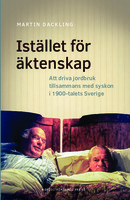Istället för äktenskap
Att driva jordbruk tillsammans med syskon i 1900-talets Sverige
| dc.contributor.author | Dackling, Martin | |
| dc.date.accessioned | 2018-09-10 23:55 | |
| dc.date.accessioned | 2019-02-05 11:03:46 | |
| dc.date.accessioned | 2020-04-01T12:29:13Z | |
| dc.date.available | 2020-04-01T12:29:13Z | |
| dc.date.issued | 2018 | |
| dc.identifier | 1000461 | |
| dc.identifier | OCN: 1082942457 | en_US |
| dc.identifier.uri | http://library.oapen.org/handle/20.500.12657/29475 | |
| dc.description.abstract | "The 20th century is sometimes said to be the century of the family farm. Although the countryside changed fundamentally, the farming family - consisting of husband, wife and children - is often seen as intact. However, all farms were not driven by families of the traditional type. One alternative was that two or more of the children took over the farm together, continued to live in the same household and remained unmarried. But how common were such sibling farms? How did they work and what were the motives behind the siblings' choice to live together? Based on household analyzes, government reports and interviews, historian Martin Dackling in Instead of marriage sketches the history of the sibling farms. He shows that they were neither unusual nor remains of an older peasant society. From the beginning of the 19th century, it became increasingly common for brothers and sisters to take over the farm together and in the 1930s and 1940s sibling farms were a common feature of Swedish countryside. However, after 1950 they became increasingly unusual. The book discusses why the sibling farms arose and Dackling points to cultural, social and economic explanations. An important circumstance was also that most of the siblings remained unmarried. Love relations were not missing, but marriage was difficult to combine with siblings living in the same household. Love relations and sibling relations were in a complicated correlation with each other, and on many farms, living with siblings became an alternative to marriage. " | |
| dc.language | Swedish | |
| dc.subject.classification | thema EDItEUR::N History and Archaeology | en_US |
| dc.subject.classification | thema EDItEUR::3 Time period qualifiers::3M c 1500 onwards to present day::3MP 20th century, c 1900 to c 1999 | en_US |
| dc.subject.classification | thema EDItEUR::N History and Archaeology::NH History::NHT History: specific events and topics | en_US |
| dc.subject.classification | thema EDItEUR::N History and Archaeology::NH History::NHT History: specific events and topics::NHTB Social and cultural history | en_US |
| dc.subject.classification | thema EDItEUR::J Society and Social Sciences::JB Society and culture: general::JBS Social groups, communities and identities::JBSC Rural communities | en_US |
| dc.subject.other | Family and household | |
| dc.subject.other | Sibling relations | |
| dc.subject.other | Rural conditions | |
| dc.subject.other | Inheritance | |
| dc.subject.other | Marriage patterns | |
| dc.subject.other | Property relations | |
| dc.title | Istället för äktenskap | |
| dc.title.alternative | Att driva jordbruk tillsammans med syskon i 1900-talets Sverige | |
| dc.type | book | |
| oapen.identifier.doi | 10.21525/kriterium.12 | |
| oapen.relation.isPublishedBy | 7b034f4a-b816-4718-88ac-63b24c8e4b24 | |
| oapen.relation.isbn | 9789188661432 | |
| oapen.pages | 264 | |
| oapen.place.publication | Gothenburg | |
| oapen.identifier.ocn | 1082942457 |

